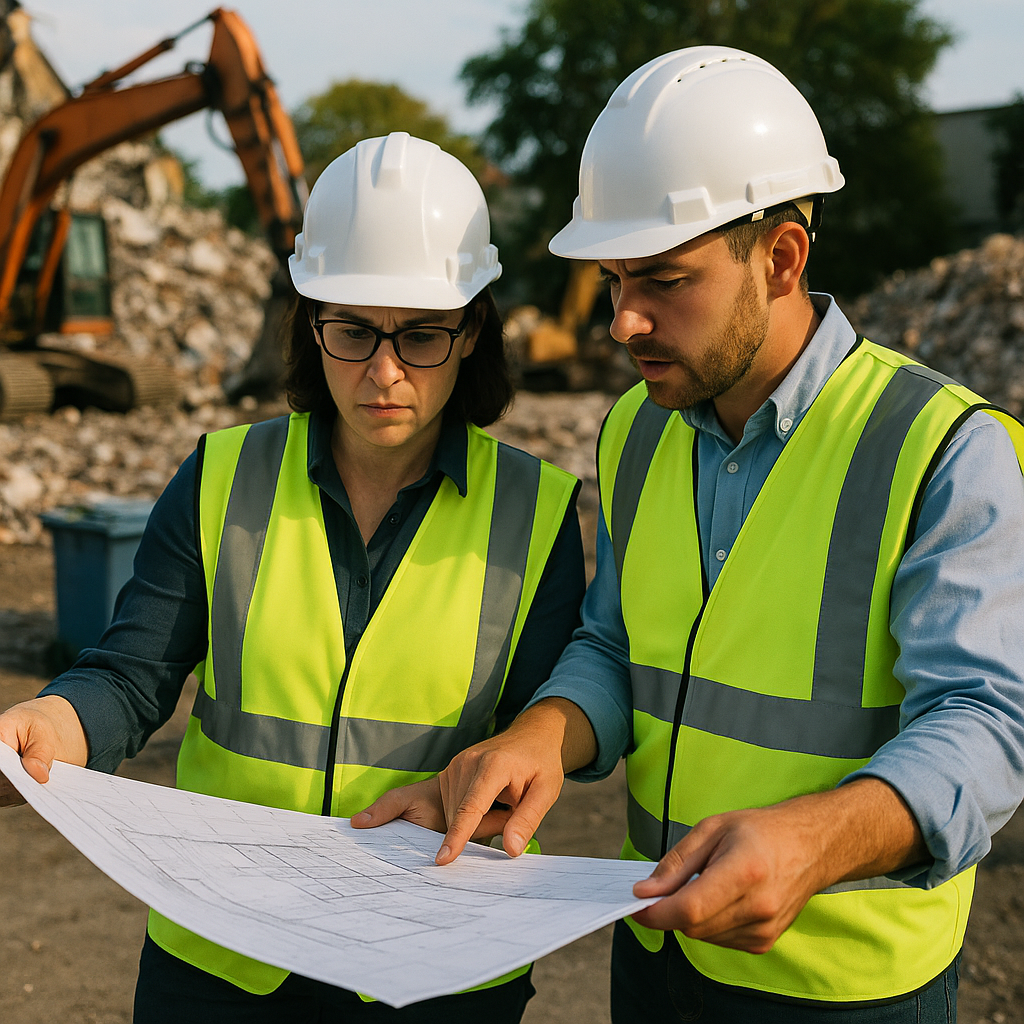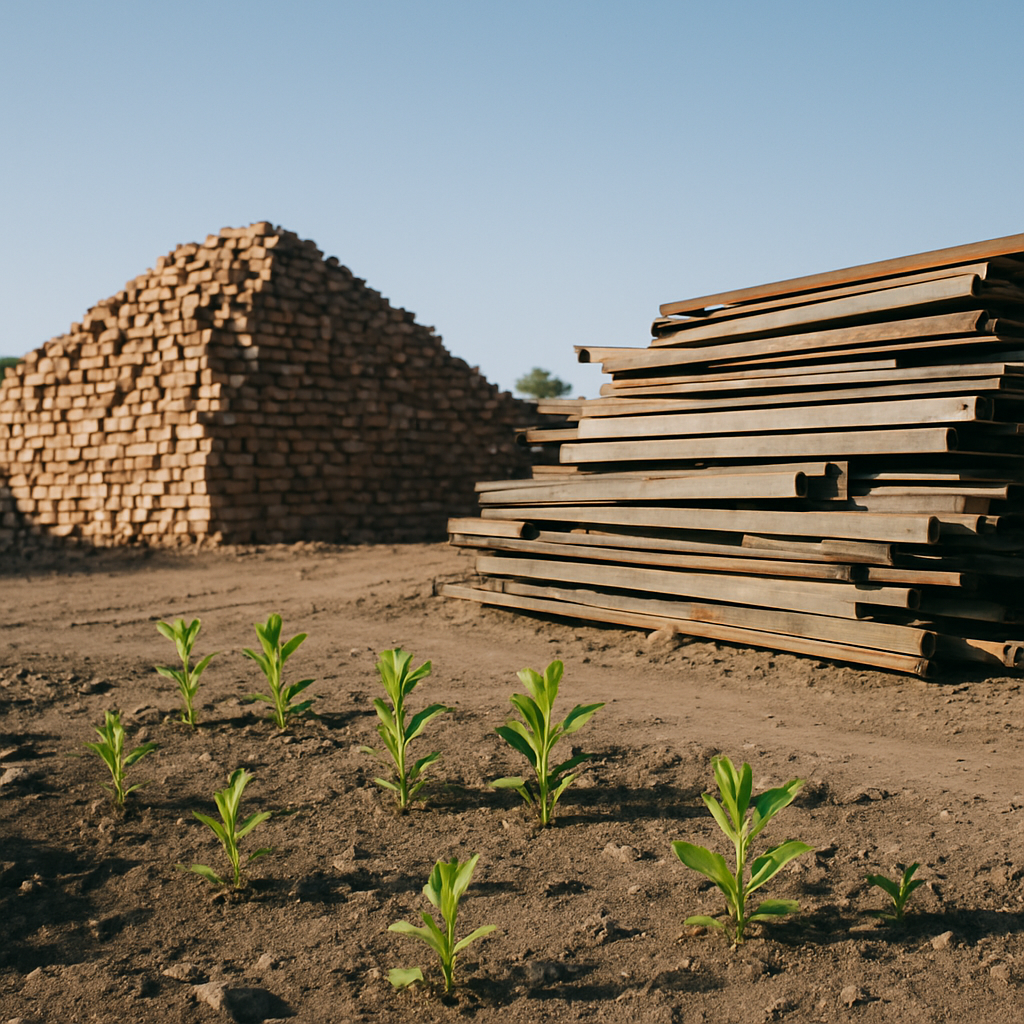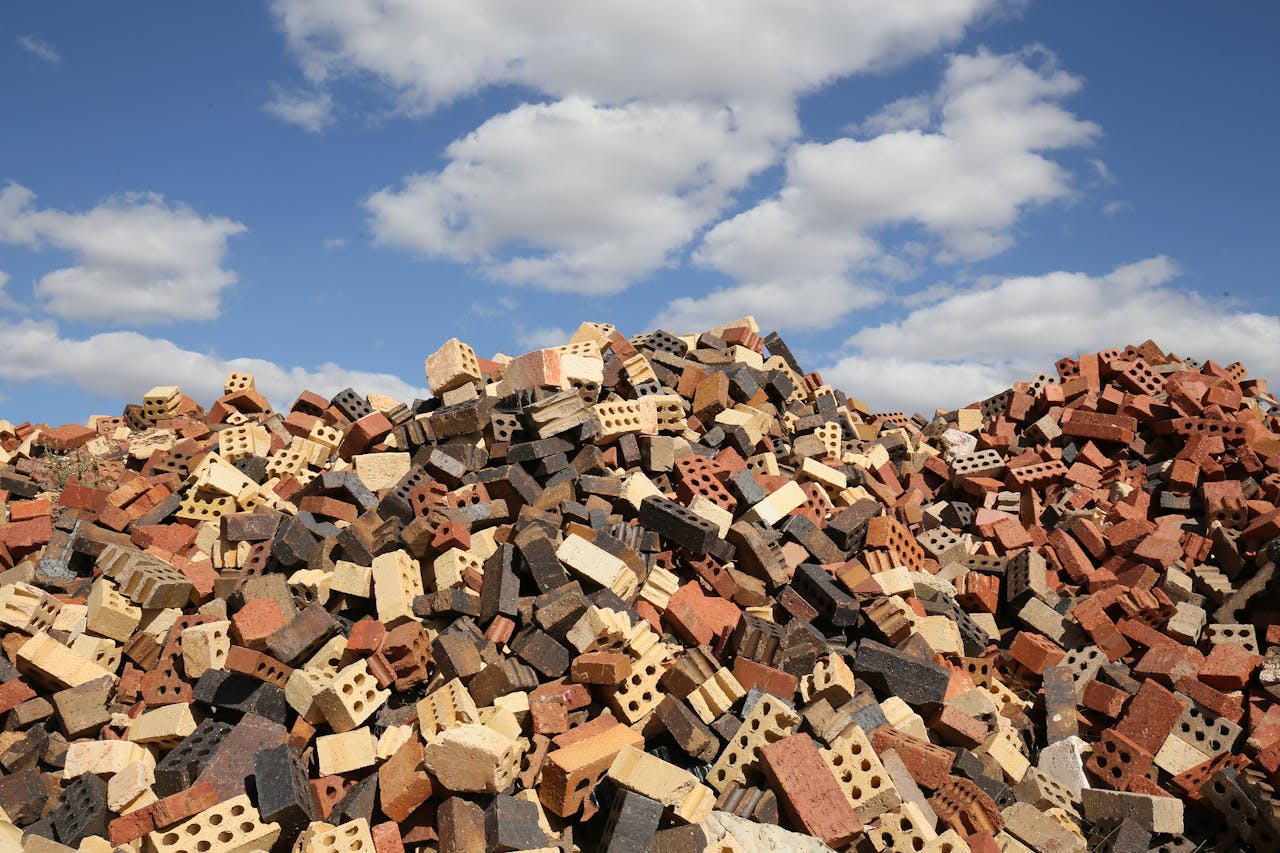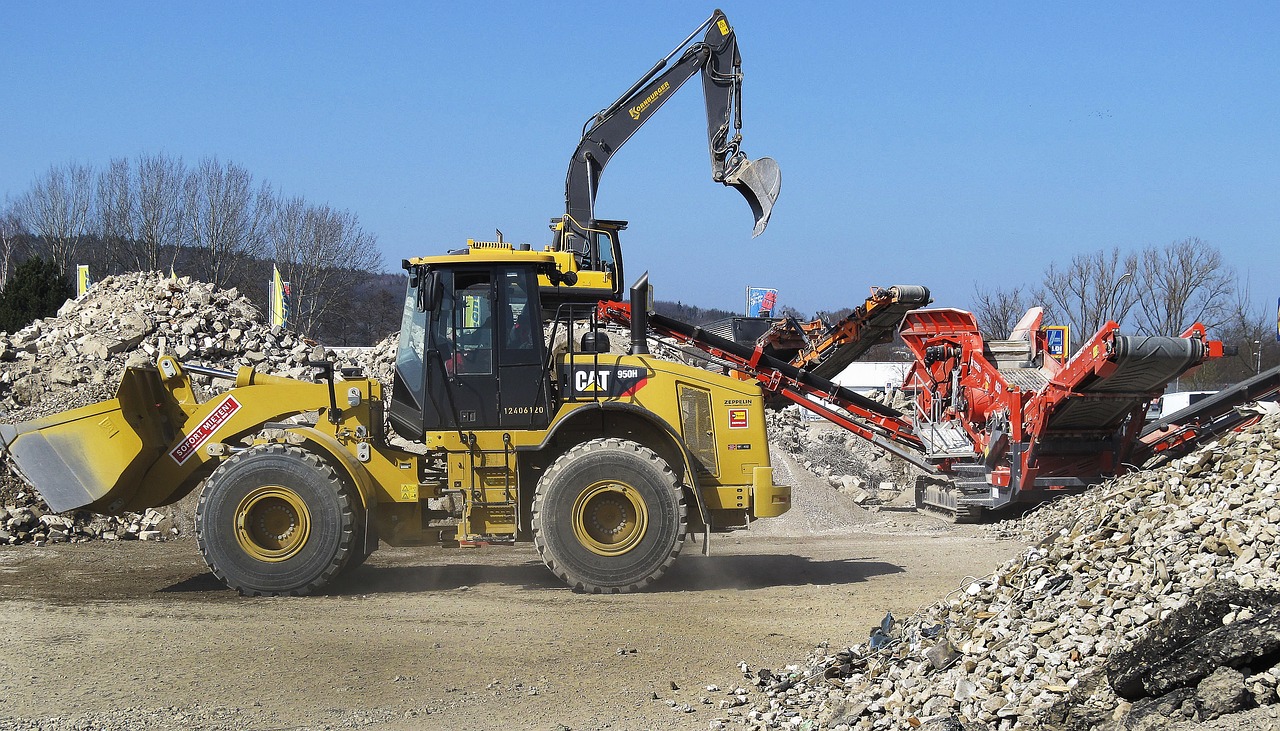5901 Botham Jean Blvd, Dallas, TX 75215
What Are Sustainable Demolition Waste Solutions?
June 20, 2025Each year, demolition projects generate millions of tons of waste destined for landfills, much of which could be repurposed. Sustainable demolition waste solutions offer a more environmentally friendly approach by carefully deconstructing buildings to maximize material recovery and recycling.
Traditional demolition often reduces structures to rubble using heavy machinery and force, creating mixed waste that’s difficult to sort and recycle. In contrast, sustainable demolition regards buildings as repositories of valuable materials ready to be recovered.
Sustainable practices include selective demolition, material assessment before teardown, and careful deconstruction methods. These techniques preserve valuable components like wood, metal, concrete, and fixtures for reuse or recycling. By diverting materials from landfills, these solutions alleviate pressure on overcrowded disposal sites and conserve natural resources.
What Are the Key Components of a Sustainable Demolition Plan?

A sustainable demolition plan transforms traditional practices into opportunities for resource recovery and environmental conservation. By implementing strategic material management, organizations can significantly reduce waste while recovering valuable resources. Explore the essential components of an effective sustainable demolition strategy.
Comprehensive Waste Audit
The cornerstone of any sustainable demolition project is a thorough waste audit. This assessment involves cataloging all materials present in the structure and identifying those with recycling or reuse potential.
A proper waste audit includes documenting types and quantities of materials such as concrete, metals, wood, glass, and plastics. This inventory enables precise planning for material recovery and helps quantify the potential environmental benefits of the project.
With actionable data from the audit, demolition teams can set clear diversion targets and optimize resource recovery strategies. Construction materials like structural steel, copper wiring, and hardwood flooring often have significant salvage value when properly identified and handled.
Selective Demolition Techniques
Unlike traditional demolition, where structures are completely razed, selective demolition involves carefully dismantling specific building components to preserve valuable materials. This approach maximizes material recovery and supports circular economy principles.
Trained crews remove reusable elements like doors, windows, fixtures, and architectural features before heavy demolition begins. This sequencing prevents contamination between different material streams and maintains the integrity of salvageable items.
Selective demolition may require specialized tools and techniques to minimize damage to recoverable materials. While more labor-intensive than conventional demolition, the environmental benefits and material resale value often offset additional costs.
Advanced Recycling Technologies
Modern recycling technologies play a crucial role in processing materials that can’t be directly reused. On-site and off-site processing systems transform demolition waste into valuable resources for new construction projects.
Concrete crushing equipment can process old concrete into aggregate for new building foundations or road base. Metal separation technologies recover ferrous and non-ferrous metals from mixed debris, while wood processing systems convert timber into mulch, biomass fuel, or engineered wood products.
GPS-guided machinery and specialized sorting equipment increase efficiency and accuracy in material separation. These technologies allow for higher recovery rates and better quality recycled materials that meet industry standards.
Material Recovery and Management Strategies
Effective material management requires clear protocols for sorting, storing, and transporting recovered materials. Establishing designated collection areas on-site helps maintain separation between different material streams.
Creating partnerships with recycling facilities, salvage yards, and material resellers ensures recovered items find appropriate markets. Material tracking systems document quantities diverted from landfills, providing valuable data for sustainability reporting.
| Construction Type | Recyclable Materials | Recovery Potential | Common Applications |
|---|---|---|---|
| Concrete Structures | Concrete, Rebar, Steel | 70-90% | Aggregate for new construction, road base, landscaping |
| Steel Frame Buildings | Structural Steel, Metal Components | 80-98% | New steel production, manufacturing, construction |
| Wood Frame Construction | Timber, Dimensional Lumber | 60-80% | Reuse in construction, furniture making, biomass fuel |
| Masonry Buildings | Brick, Stone, Mortar | 75-85% | Decorative elements, paving, aggregate |
| Mixed Commercial | Glass, Copper, Aluminum, Fixtures | 65-85% | Recycling into new materials, architectural salvage |
Training personnel in proper handling techniques for different materials prevents cross-contamination and maintains material value. Regular monitoring and adjustment of recovery strategies throughout the project maximize diversion rates and resource recovery.
Regulatory Compliance and Documentation
Sustainable demolition must adhere to federal, state, and local regulations governing waste management and environmental protection. This includes proper handling of hazardous materials like asbestos, lead paint, and chemical contaminants.
Documenting material recovery through waste manifests and recycling receipts provides evidence of regulatory compliance. Many jurisdictions now require construction and demolition waste management plans that specify diversion targets and strategies.
Maintaining detailed records of material quantities and destinations supports sustainability certification programs like LEED. These records also provide valuable data for measuring environmental impact reduction and reporting on sustainability goals.
How Can Organizations Maximize Material Recovery in Demolition?
Maximizing material recovery during demolition projects requires a strategic approach focused on preservation and sorting. Organizations that implement selective demolition techniques can significantly increase the amount of materials salvaged for reuse or recycling. This process involves carefully dismantling structures rather than indiscriminately tearing them down, preserving valuable components like wood beams, fixtures, and architectural elements.
Effective on-site waste sorting systems are essential for material recovery success. By establishing designated collection areas for different material types, demolition crews can efficiently separate concrete, metal, wood, glass, and plastics. This systematic approach prevents cross-contamination of materials and enhances their recyclability. Some advanced demolition sites even employ automated sorting technologies that use sensors and robotics to identify and separate materials with greater precision.
Partnerships with specialized recycling facilities provide organizations with expert guidance on material recovery. These facilities have the equipment and expertise to process specific types of demolition waste, from crushing concrete into reusable aggregate to processing metal scraps for manufacturing. Establishing relationships with these partners before beginning demolition projects allows organizations to develop tailored recovery plans based on local recycling capabilities and market demand.
Common Materials Worth Recovering
Concrete represents one of the most abundant materials in demolition projects and offers excellent recovery potential. When properly processed, recovered concrete can be crushed into aggregate for use in new construction projects, road base, or landscaping applications. This diverts substantial weight from landfills while reducing the need for virgin aggregate extraction.
Metals hold particularly high value in the recycling stream. Steel beams, copper wiring, aluminum siding, and other metal components can be separated and sold to scrap dealers or directly to manufacturers. The energy savings from recycling metals rather than mining and processing new ore are substantial. For instance, recycling aluminum saves approximately 95% of the energy required to produce new aluminum from raw materials.
Wood recovery varies based on quality and condition. High-quality timbers and dimensional lumber can be directly reused in new construction, while damaged wood might be processed into engineered wood products, mulch, or biomass fuel. Historic buildings often contain old-growth lumber with unique character and strength properties that command premium prices in the architectural salvage market.
Glass from windows and fixtures can be recycled into new glass products or processed into materials like glass aggregate for concrete or filtration media. Other recyclable materials include asphalt shingles (processed for road construction), gypsum wallboard (used in cement manufacturing or soil amendment), and various plastics.
Environmental and Economic Benefits
Material recovery delivers significant environmental benefits by conserving natural resources and reducing the demand for raw materials. When organizations prioritize recovery, they help minimize energy consumption associated with extracting, processing, and transporting virgin materials. For example, recycling one ton of steel conserves 2,500 pounds of iron ore, 1,400 pounds of coal, and 120 pounds of limestone.
From an economic perspective, material recovery can substantially reduce disposal costs. Landfill tipping fees continue to rise across the country, making waste disposal increasingly expensive. By diverting materials from landfills, organizations can avoid these fees while potentially generating revenue through the sale of valuable recovered materials like metals and quality wood.
Supporting the circular economy represents another important benefit of material recovery. This economic model focuses on keeping materials in productive use rather than discarding them after a single use. When demolition materials find new purposes in construction projects, they complete a circular pattern that maximizes resource efficiency and minimizes waste.
Organizations implementing comprehensive material recovery programs can also strengthen their environmental reputation and meet sustainability goals. As regulatory requirements and stakeholder expectations increasingly emphasize responsible waste management, demonstrating commitment to material recovery can enhance corporate image and stakeholder relationships.
| Material | Recovery Rate | Applications | Environmental Benefits |
|---|---|---|---|
| Concrete | 82% | Aggregate for new concrete, roadways, pathways, road base, landscaping | Reduces landfill waste, conserves natural resources |
| Asphalt | 80% | Road construction, new paving materials | Reduces need for virgin materials |
| Metal | 98% | Recycled into new metal products, construction materials | Significant energy savings (74%), reduces mining impact |
| Wood | 10% | Furniture, flooring, decorative applications, engineered wood products, mulch, biomass fuel | Preserves forests, reduces need for new timber |
| Glass | Decorative concrete, countertops, flooring, filtration media | Reduces waste, conserves raw materials | |
| Brick | Landscaping, decorative elements, pathways, retaining walls | Reduces need for new materials | |
| Fixtures/Components | Direct reuse in new construction, architectural salvage | Extends product lifecycle, reduces manufacturing |
The most successful material recovery initiatives begin with thorough planning. Conducting pre-demolition assessments helps identify recoverable materials before the project starts. These assessments can optimize recovery strategies, ensuring that valuable materials are properly targeted for salvage. Organizations that invest in training demolition teams in selective dismantling techniques and proper material handling will maximize their recovery rates and material value.
What Are the Environmental Benefits of Sustainable Demolition?

Sustainable demolition practices offer significant environmental benefits beyond the construction site. These approaches transform a traditionally wasteful process into an opportunity for conserving resources and protecting the environment.
The most immediate benefit is the substantial reduction in landfill waste. Traditional demolition methods typically send 90% of building materials to landfills, whereas sustainable practices can divert up to 80-90% of demolition waste through recycling and reuse. This reduction prevents the release of methane gas, which occurs when organic materials decompose in landfills.
Greenhouse gas emissions decrease significantly with sustainable demolition. Reusing and recycling materials like steel, concrete, and wood reduces the need for new material production, which requires substantial energy and produces considerable carbon emissions. For instance, recycling one ton of steel saves approximately 1.5 tons of iron ore and reduces CO2 emissions by 86% compared to producing new steel.
Natural resource conservation is another critical benefit. By salvaging and repurposing materials such as timber, metals, and bricks, sustainable demolition reduces the demand for virgin resources. This conservation helps protect forests, mineral deposits, and other natural resources, allowing ecosystems to recover rather than face further extraction activities.
Sustainable demolition reduces the risk of soil and groundwater contamination. These practices implement dust suppression techniques and proper waste management protocols to prevent hazardous substances from entering the surrounding environment, thus preventing materials like lead paint, asbestos, and chemicals from contaminating soil or leaching into groundwater.
Local biodiversity protection is an often overlooked advantage of sustainable demolition. By protecting nearby habitats during deconstruction, sustainable demolition helps maintain ecosystem health. This includes scheduling work outside breeding seasons, installing barriers to prevent debris from entering waterways, and implementing erosion control measures to safeguard plant and animal habitats.
Air quality improves with sustainable demolition techniques. The careful deconstruction process and use of dust suppression methods significantly reduce airborne particulates compared to traditional demolition, protecting both workers and surrounding communities from respiratory issues and other health concerns.
Noise pollution associated with demolition activities also decreases with sustainable approaches. Selective dismantling techniques typically generate less noise than conventional methods, reducing disturbances to wildlife and nearby communities.
These environmental benefits contribute to broader sustainability goals, helping communities and businesses reduce their ecological footprint while promoting responsible resource management. As construction and demolition waste accounts for approximately 40% of the solid waste stream in many developed countries, sustainable demolition practices offer a significant opportunity to advance environmental protection efforts.
Local governments increasingly recognize these benefits, with many now offering incentives for sustainable demolition, further encouraging their adoption across the industry.
How Can Companies Implement Sustainable Demolition Practices?

Implementing sustainable demolition practices involves a strategic shift and investment in new technologies. Companies should transition from the traditional demolish-and-discard model to a circular system that prioritizes material recovery and reuse.
Develop a Comprehensive Waste Management Plan
The foundation of sustainable demolition is a detailed waste management plan created before any physical work begins. This plan should identify all materials within the structure and outline strategies for their recovery, reuse, or recycling.
Effective plans include quantifiable targets for waste diversion from landfills. Leading companies often aim for 80-90% waste diversion, tracking progress throughout the project.
Pre-demolition material audits are essential components of the plan. These assessments identify salvageable items like structural beams, bricks, fixtures, and architectural elements that can be directly reused.
Invest in Specialized Equipment
Sustainable demolition requires equipment designed for precision rather than just destruction. Hydraulic shears and crushers are more energy-efficient than traditional wrecking balls and offer greater control over the deconstruction process.
Mobile crushing and screening equipment enables on-site processing of concrete and masonry into reusable aggregate, eliminating transportation costs and associated emissions while creating valuable recycling streams.
Dust suppression technologies are equally important. Water spray systems, misting cannons, and dust collection equipment minimize airborne particles that pose environmental and health risks.
Train Staff in Sustainable Techniques
Staff training is crucial for successful sustainable demolition. Workers need specialized knowledge in material identification, selective dismantling techniques, and proper handling of potentially hazardous materials.
Training programs should cover deconstruction methodologies that preserve the integrity of salvageable materials. Workers must know how to carefully remove components without damaging them, maximizing their potential for reuse.
Safety training must also be enhanced to address the unique challenges of deconstruction work, which often involves more manual handling than mechanized demolition.
Establish Recycling Partnerships
Strategic partnerships with recycling facilities and material processors are essential for sustainable demolition. These relationships ensure recovered materials have appropriate destinations for processing and eventual reuse.
Companies should connect with specialized recyclers that handle specific materials like metals, wood, concrete, and glass. Establishing relationships with architectural salvage operations can provide outlets for fixtures, doors, windows, and decorative elements.
Local manufacturers that use recycled content in their production processes can become valuable partners, creating direct pathways for materials to reenter the supply chain.
Stay Informed About Regulations and Technologies
The regulatory landscape around demolition waste management continues to evolve. Companies must stay current with local, state, and federal requirements regarding material disposal, hazardous waste handling, and landfill diversion.
Industry associations and sustainability certifications can provide guidance on best practices and emerging technologies. Organizations like the Construction & Demolition Recycling Association offer resources and networking opportunities for companies committed to sustainable practices.
Regular participation in industry conferences and training sessions helps companies stay at the forefront of sustainable demolition innovations.
Implement Pollution Control Measures
Effective pollution control is critical for sustainable demolition. Companies must implement measures to control dust emissions through water spraying, dust collection systems, and protective barriers around the demolition site.
Proper handling and disposal of hazardous materials like asbestos and lead-based paint require specialized protocols to prevent environmental contamination.
Silt fences, sediment basins, and other erosion control methods prevent demolition debris from entering stormwater systems, protecting local water sources and ecosystems.
| Phase | Timeline | Activities | Resource Requirements |
|---|---|---|---|
| Pre-Demolition Planning | 4-6 weeks | Conduct waste audit, identify salvageable materials, obtain permits, develop waste management plan | Environmental consultants, structural engineers, waste management specialists |
| Hazardous Material Removal | 2-3 weeks | Identify and safely remove asbestos, lead paint, chemicals, PCBs | Certified hazardous material specialists, containment equipment, PPE |
| Selective Dismantling | 3-4 weeks | Carefully remove reusable components (fixtures, doors, windows, architectural elements) | Skilled labor, hand tools, material sorting areas, storage containers |
| Structural Demolition | 2-4 weeks | Controlled demolition with material separation, dust suppression measures | Specialized equipment (hydraulic shears, crushers), dust control systems, trained operators |
| Material Processing | Ongoing | On-site crushing of concrete, metal separation, wood processing | Mobile crushing equipment, sorting machinery, material handlers |
| Site Clearance | 1-2 weeks | Final debris removal, soil remediation if needed, site preparation | Excavators, trucks, soil testing equipment |
| Documentation & Reporting | Throughout project | Track material recovery rates, maintain disposal records, prepare sustainability reports | Tracking software, administrative staff, certification documentation |
By adopting these practical strategies, demolition companies can significantly reduce their environmental impact while potentially realizing economic benefits through material recovery and improved community relations. The initial investment in planning, equipment, and training pays dividends through reduced disposal costs, material resale opportunities, and enhanced reputation in a sustainability-conscious market.
Conclusion: The Future of Sustainable Demolition

Sustainable demolition practices have transitioned from being optional to essential in waste management. Companies prioritizing environmental responsibility are transforming the industry through innovative recycling and efficient material recovery. These methods not only reduce environmental impact but also offer significant cost savings through reclaimed materials and lower disposal fees.
The future of sustainable demolition is promising with advancements in AI-powered machinery, electric equipment, and precision techniques. As regulations strengthen and market demands shift towards greener practices, the demolition industry is positioned to lead in creating circular economies where today’s buildings become tomorrow’s resources.
For expert guidance on sustainable demolition practices, contact Okon Recycling at 214-717-4083. Our team specializes in maximizing material recovery while ensuring compliance with environmental regulations for your demolition projects.
